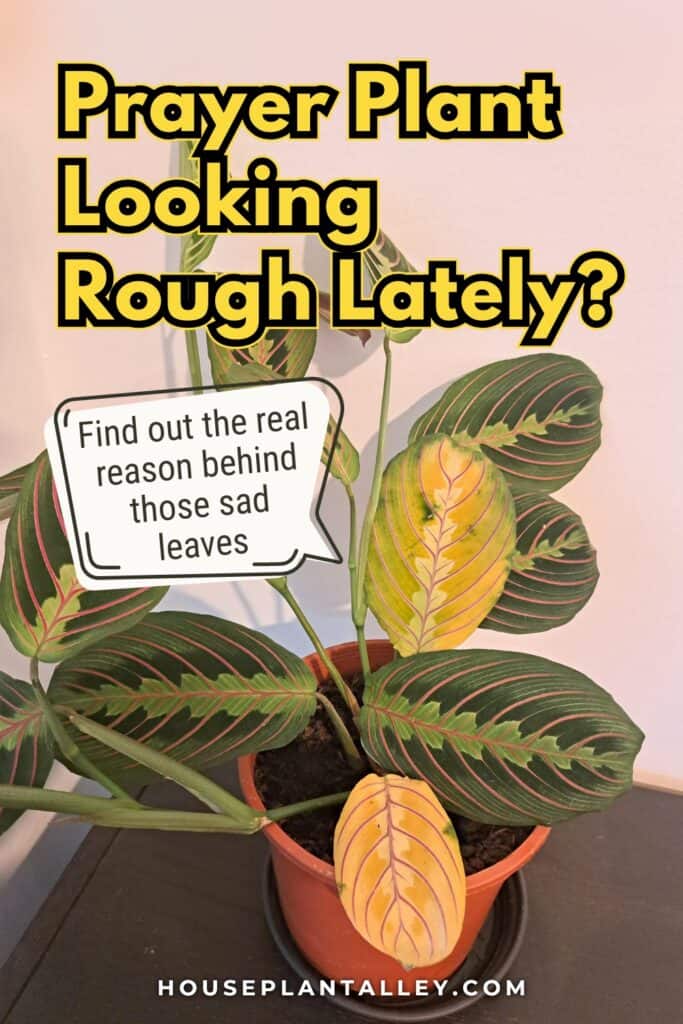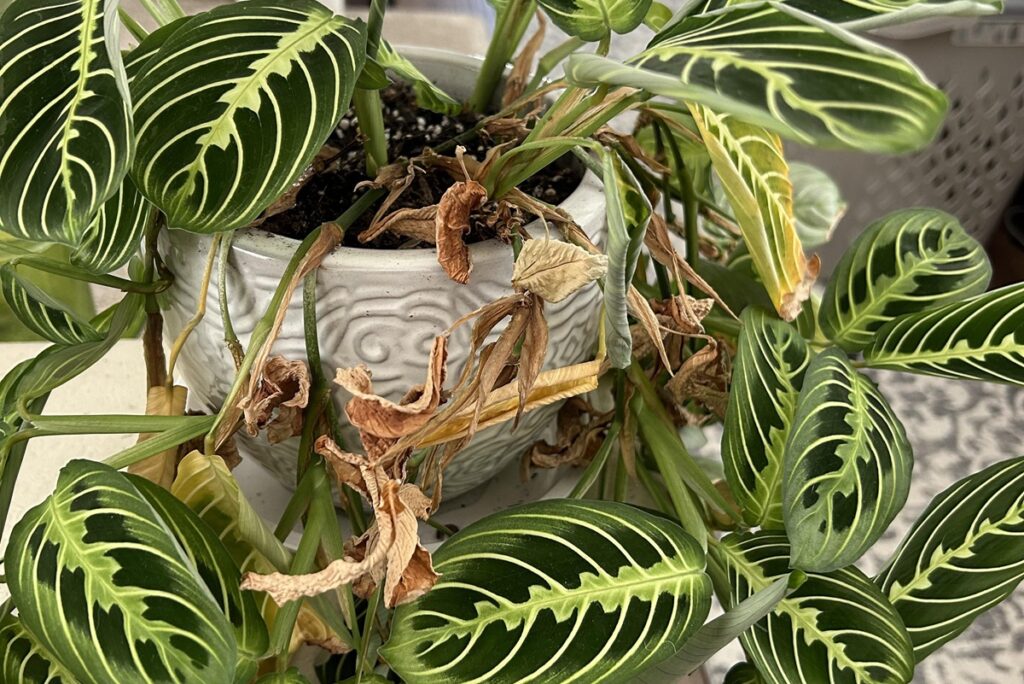You’ll find that Prayer Plants can be quite dramatic when they’re unhappy, showing their distress through various telltale signs. From crispy brown edges to mysteriously yellowing leaves, these tropical beauties have a way of communicating their needs—if you know what to look for. While they’re not the most challenging houseplants to maintain, they do require specific care conditions to thrive, and understanding their common problems is your first step toward keeping them lush and vibrant.

Contents
Identifying Brown and Crispy Leaf Edges
When your prayer plant develops brown, crispy edges on its leaves, you’re likely dealing with one of the most common issues these tropical plants face. The discoloration typically starts at the leaf tips and gradually spreads inward, creating a dry, papery texture that’s easily noticeable against the plant’s vibrant patterns.
You’ll want to inspect the affected leaves closely, noting whether the browning appears uniformly along edges or in irregular patches. Look for a clear line of demarcation between healthy and damaged tissue, as this can help distinguish between humidity issues and other problems like fertilizer burn or pest damage.

Dealing With Yellowing or Fading Foliage
If you’re noticing yellow patches or overall fading on your prayer plant’s leaves, you’ve likely encountered a common issue that stems from either lighting problems or nutrient deficiencies.
To address lighting concerns, move your plant 3-4 feet away from windows if it’s receiving direct sun. Prayer plants thrive in bright, indirect light for 6-8 hours daily. For nutrient issues, apply a balanced, water-soluble fertilizer (10-10-10) every 4-6 weeks during growing season.
Check your soil’s pH level using a testing kit – prayer plants prefer slightly acidic soil between 6.0 and 6.5. If needed, adjust with agricultural lime or sulfur accordingly.
Understanding Root Rot and Overwatering Signs
If you’re noticing mushy, dark roots and consistently wet soil in your prayer plant’s pot, you’re likely dealing with root rot, a serious fungal condition that can kill your plant if left untreated. You’ll often spot early warning signs like yellowing leaves, wilting despite wet soil, and a foul, musty smell coming from the pot’s drainage holes. While root rot might seem devastating, you can save your prayer plant by immediately removing it from wet soil, trimming away affected roots with sterilized scissors, and repotting in fresh, well-draining medium.
Root Rot Warning Signs
Root rot manifests through several unmistakable warning signs in prayer plants, often appearing before you’ve noticed you’re overwatering. You’ll spot yellowing leaves, starting from the outer edges and progressing inward, accompanied by a mushy, soft texture at the base of the stems.
Check the soil’s moisture level by inserting your finger 2 inches deep – if it feels consistently wet after 5-7 days since watering, you’ve got a problem. The most telling sign is the roots themselves: healthy roots are firm and white, while rotted roots turn brown or black, feel slimy to touch, and may emit a foul, swampy odor.
Prevention and Recovery Methods
Once you’ve identified the warning signs of root rot, taking swift action can save your prayer plant from decline. Start by removing the plant from its pot and gently washing away soil from the roots. Using sterile scissors, trim away any brown, mushy roots while preserving healthy white ones.
Repot your plant in fresh, well-draining potting mix with 30% perlite, and verify the new container has proper drainage holes. Wait 24 hours before watering, then maintain a careful watering schedule – only water when the top inch of soil feels dry.
To prevent future issues, increase air circulation around your plant and check soil moisture weekly with a moisture meter.
Treating Common Prayer Plant Pests
While prayer plants are generally hardy houseplants, they can fall victim to several common pests that’ll damage their distinctive foliage. Spider mites, mealybugs, and scale insects are the most frequent offenders you’ll need to combat.
For spider mites, spray leaves with neem oil solution (2 tablespoons per gallon of water) every 7 days until they’re gone. To tackle mealybugs, dab them directly with rubbing alcohol using a cotton swab. For scale, scrape off visible insects with a soft brush, then apply insecticidal soap.
Prevent future infestations by inspecting leaves weekly and maintaining humidity above 60% with regular misting.
Fixing Curled and Drooping Leaves
Curled and drooping leaves on your prayer plant often signal that something’s off with its basic care routine. When leaves curl inward and droop, check your humidity levels first – they should stay between 50-60%. Place a humidity tray filled with pebbles and water nearby, or mist leaves daily.
Temperature fluctuations below 60°F can also cause leaf curling. Move your plant away from drafty windows and air vents, keeping it in a spot that maintains 65-80°F. If leaves remain curled, examine your watering habits – the soil should feel consistently moist but never waterlogged. Always water when the top inch feels dry.
Addressing Leaf Pattern Loss and Discoloration
The vibrant patterns on your prayer plant’s leaves can fade or discolor when critical nutrients are lacking in the soil. You’ll need to supplement with a balanced fertilizer (10-10-10) every 4-6 weeks during the growing season to maintain those striking markings.
If you notice yellowing between leaf veins, your plant’s likely suffering from iron deficiency. Apply an iron supplement at half strength, or adjust your soil’s pH to 6.0-6.5 for better nutrient absorption.
Brown spots with yellow halos typically indicate a magnesium deficiency. Mix 1 tablespoon of Epsom salts per gallon of water, and apply this solution monthly during active growth.
Managing Humidity and Temperature Stress
Your prayer plant craves humidity levels between 50-60%, which you’ll need to maintain through regular misting or a humidity tray. Since these tropical beauties can’t handle temperatures below 55°F (13°C), you’ll want to keep them away from drafty windows and air conditioning vents. If you notice curled or crisping leaves, it’s often a sign that your plant needs more moisture in the air, rather than more water in the soil.
Optimal Humidity Zone
Most prayer plants thrive in humidity levels between 50-60%, making moisture management essential for their success. You’ll notice your plant’s response through its leaf appearance and overall health.
To maintain this sweet spot, you can use a humidity tray filled with pebbles and water, keeping the pot elevated above the water line. If you’re in a drier climate, consider running a humidifier nearby for 4-6 hours daily.
Monitor humidity using a digital hygrometer, placed within 6 inches of your plant. When levels drop below 45%, it’s time to boost moisture through misting or increasing humidifier output. Just don’t let water collect on the leaves.
Cold Damage Prevention
While prayer plants can endure brief temperature fluctuations, prolonged exposure to cold air below 60°F (15°C) triggers rapid leaf damage and wilting. You’ll notice brown edges, curling leaves, and eventual leaf drop if your plant faces cold stress.
To prevent cold damage, keep your prayer plant away from drafty windows, air conditioning vents, and exterior doors. During winter months, maintain indoor temperatures between 65-75°F (18-24°C), and consider using a space heater if needed.
If you’ve noticed early signs of cold damage, don’t panic – move your plant to a warmer location immediately and trim affected leaves. The plant will typically recover within 2-3 weeks with proper care.
